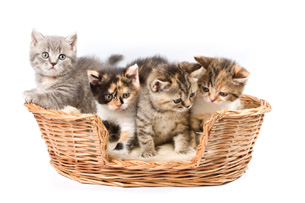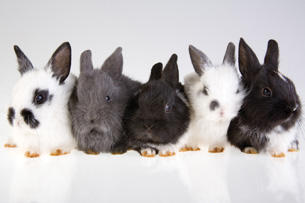Module 6
1. Module 6
1.14. Page 2
Module 6—Mendelian Genetics: The Transmission of Traits to the Next Generation
 Explore
Explore
 Read
Read

© Utekhina Anna/shutterstock
Pardeep’s tomcat, Smokey, was her pride and joy; dusty grey with chocolate brown spots, he was unique to the neighbourhood. One day, a new family moved in next door. To Pardeep’s surprise they had a female cat, also grey with chocolate spots. When the neighbours discovered Pardeep’s cat, they immediately requested its siring services—they wanted to breed Pardeep's cat to their cat. Ten weeks later, the female gave birth to six kittens. Hopes of the unique grey and chocolate combination were dashed as only one kitten, a male, showed the parental colours. Four kittens were solid grey, and a fifth was completely white.
Why are there three phenotypes in this case instead of only two as in all monohybrid crosses studied so far? What is the explanation for this curious genetic phenomenon that seems to be inconsistent with Mendel's observations?
Read “Incomplete Dominance and Co-dominance” on pages 594 and 595 of your text. Record this information according to your learning style, and then answer the following questions to ensure your understanding. Save the results in your course folder.
TR 1. Four-o'clock flowers occur in two pure-breeding varieties, one with white flowers and the other with red flowers. If these are crossed, all of the F1s have pink flowers. Give the genotype of each parent, and the genotypes of the F1s of such a cross. Use R1 and R2 to represent the alleles for red and white respectively.
TR 2. The phenotype of the F1s is pink flowers that appear to be a blend of the two originals. It is an intermediate type. What is its genotype?
TR 3. How does the phenotypic ratio change for a monohybrid cross with no dominance, as compared to a Mendelian cross where there is dominance?
TR 4. In the case of co-dominance and incomplete dominance, pure-breeding individuals are easily identified. Explain this statement.
TR 5. Use a Punnett square to find the probability of producing a blue roan horse if you cross a roan mare with a black stallion.
TR 6. Can you generally explain the results of breeding Pardeep’s tomcat with the neighbour's spotted cat?
 Watch and Listen
Watch and Listen
Watch the video “Alternate Patterns of Inheritance: the Potential for Diversity” from the beginning to the end of “Incomplete Dominance.” Answer the following questions and share your work with your teacher. Save the results in your course folder.
TR 7. What are multiple alleles?
TR 8. How many alleles can one organism have for a gene with multiple alleles?
TR 9. Define or explain co-dominance.
TR 10. What is incomplete dominance?
TR 11. How do the phenotypic and genotypic ratios compare for an incomplete dominant trait?
 Module 6: Lesson 3 Assignment—Lab
Module 6: Lesson 3 Assignment—Lab

© Ferenc Szelepcsenyi/shutterstock
In the animal kingdom, two phenotypically different parents often produce several different phenotypes in the offspring. A black and a white rabbit can produce many different phenotypes, as shown in the photo. This phenomenon is observed in many livestock, such as cattle and chickens. In this lab, you will breed chickens to study the phenotypes produced from parents of your choice.
Breeding chickens has never been easier! You will complete a Gizmo on Chicken Genetics and all of the activities indicated in the lab. You will be prompted to complete the Module 6: Lesson 3 Assignment as part of the lab.